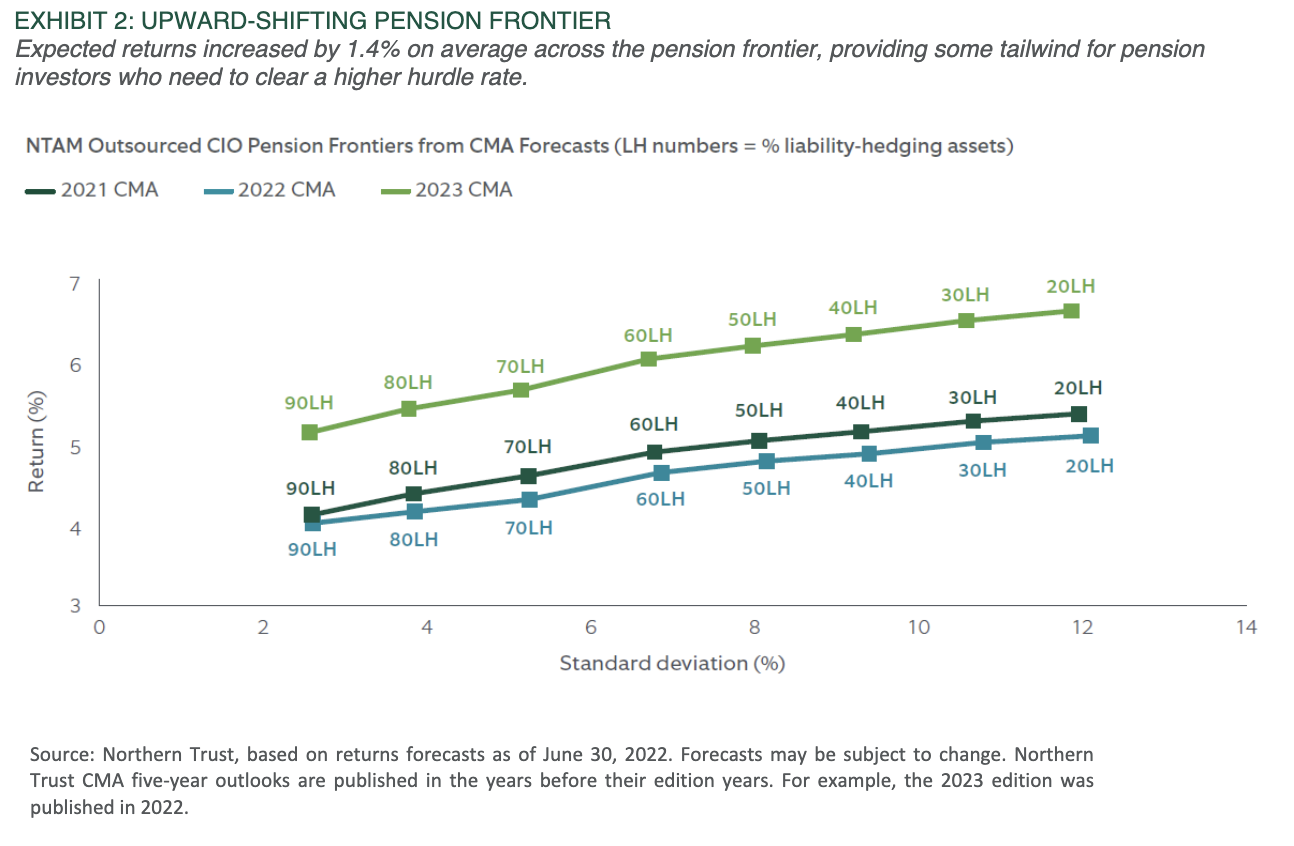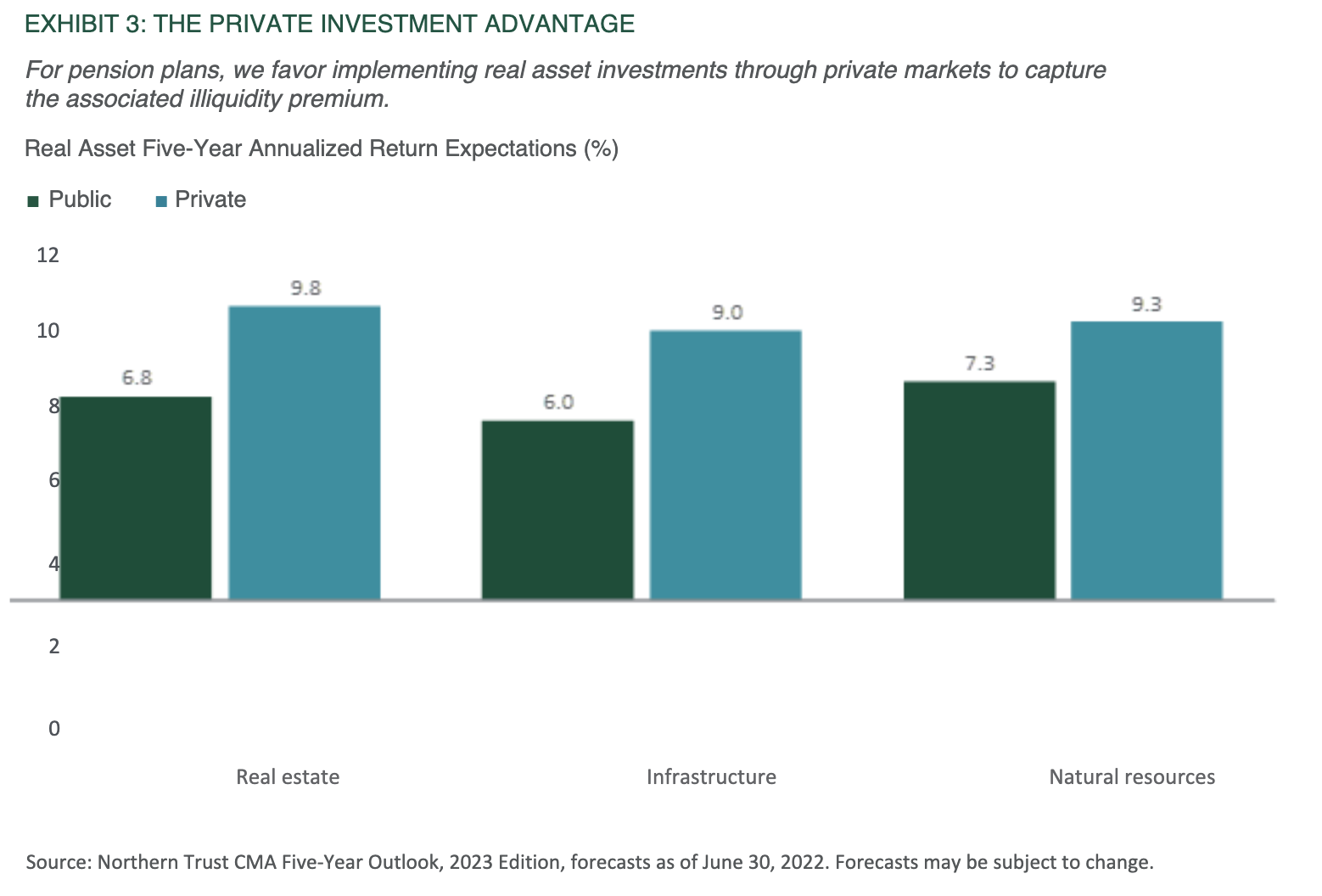
©Nuthawut Somsuk/iStock/Getty Images Plus
Despite steep losses from both stocks and bonds in 2022, pension plans on average experienced an increase in funded ratios. However, higher interest rates pose a challenge for 2023 and beyond because they raise the return required for plans to maintain their current funded ratios. Our five-year capital market assumptions research suggests three asset classes that corporate pension plans can utilize to bolster returns.
The Challenge of the Higher Hurdle
On average, accounting-based liabilities declined for defined benefit pension plans in 2022 because higher interest rates also increased the discount rate, or the rate used to calculate the present value of plan liabilities. This reduces the value of liabilities to be paid in the future. However, the increasing discount rate doesn’t impact annual cash benefit and other fixed cash payments. This potentially introduces problems because recent investment losses have lowered investable asset bases. With fewer assets available to cover the same fixed cash payments, plans may struggle to earn sufficient cash returns to maintain their current funded status. The return required to cover the benefit payments as a percentage of assets — along with the discount rate, normal costs, and fund administrative expenses — is referred to as the hurdle rate. Investment returns must sufficiently match this hurdle rate to maintain current funded ratio. .png.aspx)
Find More Return in This Environment
We see some tailwinds for pension plans needing a return boost to overcome the higher hurdle. For the first time in several years, our pension frontier’s expected returns in our five-year outlook have risen across all allocations. However, the average return in our pension frontier rose 1.4% (Exhibit 2), less than the rise in the hurdle rate. As a result, plan sponsors may need to take more investment risk or contribute more cash to their plans to achieve their short and long-term objectives.
For pension portfolios, we favor looking at three areas — real assets (ideally in the form of private assets), high yield bonds and cash —to help address the gap between expected returns and hurdle rates.

Real Assets as Inflation Hedges
To enhance performance, plan sponsors may look at traditional inflation-hedging through real asset investments such as real estate, infrastructure and natural resources. Differing economic factors drive these asset classes, so they provide divergent inflation hedges. Generally speaking, our five-year forecasts expect real assets to perform well.
To the extent a defined benefit plan’s time horizon and cash flow needs allow, we favor implementing these investments through private markets to capture the associated illiquidity premium (Exhibit 3). A diversified implementation can provide more stable returns throughout the economic cycle.

High Expectations for High Yield Bonds
We expect high yield to provide some of the highest returns — 7.3% a year on average, outpacing our 6.1% global equity forecast — of any public market asset class, yet also provide some risk control due to credit factor exposure. We find this combination attractive for those seeking higher risk-adjusted returns.
Take a Look at Cash
Because we expect the Fed funds rate to top 5 – 5.25%, it is worth considering a strategic allocation to cash for upcoming liquidity needs. Cash also provides optionality around tactical opportunities.
On a related note, we believe increasing cash contributions can make sense. With lower liabilities, deficits (in dollar terms) are the lowest in over a decade. This can make it especially cheap to fully fund the plan and significantly reduce the risk. Even modest increases in cash contributions can make sense as each marginal dollar represents a larger percentage of the deficit today than it would have a year ago. Additionally, forecasted returns over the next five years are the highest they’ve been in several years, providing more opportunity for return on cash contributions. Finally, larger cash contributions lessen uncertainty over clearing the hurdle rate.
The Path Forward for Pension Plans
Market movement over the past year has revolved around inflation, rising rates and significant losses in value for most asset classes. Corporate pensions, however, have taken the markets’ best punches and escaped with funded ratios largely intact and in many cases improved.
Looking forward, as the economy continues its transition to slower growth, we expect continued interest rate volatility and significant market sensitivity to inflation, leading to knock-on effects of equity volatility as well as the higher hurdle rates noted above.
To help match these challenges, plan sponsors can consider an increase in allocation to high yield bonds based on our expectations that they will outperform equities and their credit hedging attributes against liabilities. Plan sponsors may also want to pay special attention to creating or further diversifying their real assets portfolio to help withstand the ever-changing sources of inflation risk as the cycle evolves. Finally, we believe increasing or accelerating cash contributions to take advantage of higher expected returns as well as potentially alleviate some of the concerns around higher hurdle rates is worth consideration.
How Northern Trust Asset Management Can Help
As the country’s 5th largest Outsourced Chief Investment Officer (rankings are based on AUM of $95B and referencing data from the P&I Research Center, as of 3/31/2022), Northern Trust Asset Management has provided asset allocation, LDI (Liability-driven investing) and contribution strategy advice to plan sponsors for over forty years.
To learn more about our service offering and see how we can assist with the management of your plan, please visit our website: Outsourced Chief Investment Officer (OCIO) | Northern Trust
Read the full paper on this topic, How Pension Plans Can Clear a Higher Hurdle.
For methodologies and disclosures regarding this article, please click here.